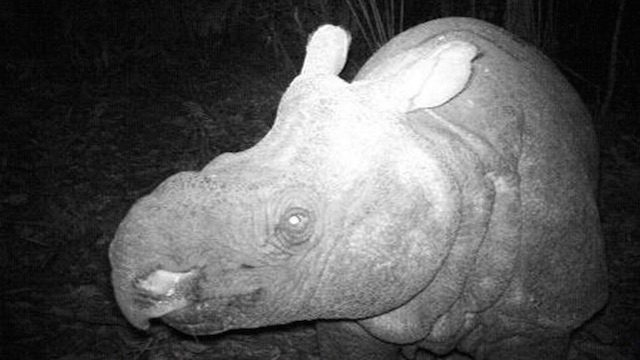SUMMARY
This is AI generated summarization, which may have errors. For context, always refer to the full article.

JAKARTA, Indonesia (UPDATED) – Three critically endangered Javan rhino calves have been filmed in an Indonesian national park, taking to 60 the total population of the world’s rarest rhino and offering hope for the creature’s future.
One female calf and two males were spotted in recent months in Ujung Kulon park, on Java island, and were all likely born in the past year in a newly established sanctuary, park chief Mohammad Haryono told AFP on Wednesday, September 9.
While individual calves have been spotted occasionally in recent years, seeing three in the space of a few months is a rare piece of good news for the shy creatures that once numbered in the thousands and roamed across Southeast Asia.
Revered in Javanese folklore as Abah Gede, or the Great Father, the rhino’s population has dramatically dwindled due to poaching and human encroachment on their habitat.
Widodo Ramono, head of conservation group the Indonesian Rhino Foundation, hailed the discovery of three new calves as “wonderful news”.
“Now we just need to ensure their protection,” he told AFP.
The population of Javan rhinos in Ujung Kulon dropped to 35 in 2011 but has been slowly increasing in recent years, according to Aom Mukhtarom, a member of the park’s rhino monitoring team.
In 2014, only one calf was spotted in the entire year, he said.
Last stand
The calves were filmed with their mothers by cameras set up to track them, Haryono said. They were all born from different mothers and both the parents and their youngsters looked healthy, he added.
Haryono said the discovery of the calves – filmed in April, May and July – brings the population of the Javan rhino to 60, all of which live in Ujung Kulon.
The International Union for Conservation of Nature (IUCN) classifies the Javan rhino – whose folds of loose skin give it the appearance of wearing armour plating – as “critically endangered” and says the creature is “making its last stand”.
Poaching in particular represents a severe threat, with rhino horns fetching high prices on the black market for use in traditional Asian medicine.
The sanctuary was established last year in the park and comprises 5,100 hectares (12,600 acres) of lush rainforest and freshwater streams.
The animals had previously been living mainly in one corner of the park, an area of stunning natural beauty, but the sanctuary expanded the area suitable for them and relocated farmers to reduce the chances of animal-human conflict.
Setting up the sanctuary in the park, which is a UNESCO World Heritage Site, took several years as the project was held up by red tape and opposition from residents demanding compensation for their farmland.
The Rhino Foundation’s Ramono said that the sanctuary – which also has an electric fence – had helped the rhinos but pointed out that most were still only visiting the protected area occasionally as they get used to the new habitat.
“The sanctuary has improved security for the rhinos, not only from poachers but also from local people passing by,” he said, but added the new protected area “does not mean all disruptions will stop for the rhinos”.
Of the three Asian rhino species, the Javan and Sumatran rhinos are classified as “critically endangered” by the IUCN, while the third, the greater one-horned rhino, is listed as “vulnerable”.
Three critically endangered Javan rhino calves have been filmed in an Indonesian national park, raising hopes for the future of the world’s rarest rhino after years of population decline.
One female calf and two males were spotted in recent months in Ujung Kulon park, on Java island, and were all likely born in the past year, park chief Mohammad Haryono told AFP on Wednesday, September 9.
The rhinos were filmed with their mothers by cameras set up to track the shy creatures in a recently established sanctuary inside the park, he said.
They were all born from different mothers and both the parents and their youngsters looked healthy, the official added.
Haryono said the discovery of the calves – filmed in April, May and July – brings the population of the Javan rhino to 60, all of which live in Ujung Kulon.
“This is wonderful news, now we just need to ensure their protection,” Widodo Ramono, head of conservation group the Indonesian Rhino Foundation, told AFP.
The Javan rhino, whose folds of loose skin give it the appearance of wearing armour plating, once numbered in the thousands and roamed across Southeast Asia.
Poaching and human encroachment on its habitat have led to a dramatic population decline, as with other rhino species around the world, and the International Union for Conservation of Nature (IUCN) has said the Javan rhino is “making its last stand”.
Poaching in particular represents a severe threat, with rhino horns fetching high prices on the black market for use in traditional Asian medicine.
The IUCN classifies the Javan rhino as “critically endangered”.
Haryono said the calves were born inside the sanctuary, which was established last year in the park and comprises 5,100 hectares (12,600 acres) of lush rainforest and freshwater streams.
The animals had previously been living mainly in one corner of the park, an area of stunning natural beauty, but the sanctuary expanded the area suitable for them and relocated farmers to reduce the chances of animal-human conflict. – Rappler.com
Add a comment
How does this make you feel?
There are no comments yet. Add your comment to start the conversation.